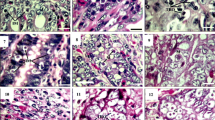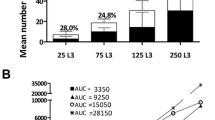Summary
The mortality ofP. berghei-infectedAnopheles stephensi females can be about 30% higher during the first three days than in normal blood-fed mosquitoes. As expected the mortality is higher after feeding on highly infected mice but also depends on the date of feeding and the temperature. Infected mosquitoes kept at 25° C die more often than those kept at 21° C. On the other hand sporozoite production needs the low temperature of 21°C. So the sporozoite production rate falls with increasing temperature, and the mortality rate increases.
Zusammenfassung
Ein Vergleich der Mortalitätsrate derAnopheles-Mücken während der Plasmodien-Entwicklung zeigt, daß die Sterblichkeit in den ersten drei Tagen um ca. 30% höher sein kann als bei Kontrolltieren, die mit normalem Blut gefüttert worden waren. Sie ist erwartungsgemäß um so höher, je größer die Parasitämie im Blut der Spendermaus war. Allerdings spielt neben dem Fütterungszeitpunkt die Temperatur eine wichtige Rolle. Infizierte Mücken sterben bei 25°C weit häufiger als bei 21°C; Sporozoitenbildung findet aber bei 21°C statt. Die Fähigkeit zur Sporozoitenbildung nimmt also mit steigender Temperatur ab, die Mortalität zu.
Similar content being viewed by others
References
Bafort, J.M.: The biology of rodent malaria with particular reference toPlasmodium vinckei vinckei Rodhain 1952. Ann. Soc. Belg. Med. Trop.51, 1–204 (1971)
Box, E.D., Celaya, B.L., Gincrish, W.D.: Development ofPlasmodium berghei inAnopheles quadrimaculatus. Am. J. Trop. Med. Hyg.2, 624–627 (1953)
Briegel, H., Lea, A.O.: Relationship between protein and proteolytic activity in the midgut of mosquitoes. J. Insect Physiol.21, 1597–1604 (1975)
Buxton, P.A.: The effect ofProteosoma upon the survival ofCulex. Parasitology27, 547–550 (1935)
De Buch, A.: Some results of six years mosquito infection work. Am. J. Hyg.24, 1–18 (1936)
Gad, A.M., Maier, W.A., Piekarski, G.: Pathology ofAnopheles stephensi after infection withPlasmodium berghei: II. Changes in amino acid contents. Z. Parasitenkd.
Garnham, P.C.C.: Malaria parasites and other haemosporidia. Oxford: Blackwell Scientific Publ. 1966
Gass, R. F.: Influences of blood digestion on the development ofPlasmodium gallinaceum (Brumpt) in the midgut ofAedes aegypti (L.). Acta Trop. (Basel)34, 127–140 (1977)
Gooding, R.H.: Physiological aspects of digestion of the blood meal byAedes aegypti andCulex fatigans. J. Med. Entomol.3, 53–60 (1966)
Gooding, R.H.: Digestive processes of haematophagous insects. I. A. literature review. Question. Entomol.8, 5–60 (1972)
Huff, C.G., Marchbank, D.F., Shiroishi, T.: Changes in infectiousness of malaria gametocytes. II. Analysis of the possible causative factors. Exp. Parasitol.7, 399–417 (1958)
Maier, W.A.: Über die Mortalität vonCulex pipiens fatigans nach Infektion mitPlasmodium cathemerium. Z. Parasitenkd.41, 11–28 (1973)
Maier, W.A.: Arthropoden als Wirte und Überträger menschlicher Parasiten: Pathologie und Abwehrreaktion der Wirte. Z. Parasitenkd.48, 151–179 (1976)
Meller, H.: Vergreichende Beobachtungen über die Biologie vonAnopheles atroparvus undAnopheles stephensi unter Laboratoriumsbedingungen. Tropenmed. Parasitol.13, 80–100 (1962)
Muirhead-Thomson, R.C.: Mosquito behavior in relation to malaria transmission and control in the tropics. London: Edward Arnold 1951
Perez-Reyez, R.:Anopheles aztecus Hoffmann 1935, a new definitive host for the cyclical transmission ofPlasmodium berghei Vincke et Lips, 1948. J. Parasitol.39, 603–604 (1953)
Ross, R.: Possible effects of malaria on anophelines. In: The prevention of malaria, pp. 197–198. London: Murray 1910
Terzian, L.A.: The sulfonamides as factors in increasing susceptibility to parasitic invasion. J. Infect. Dis.87, 285–290 (1950)
Terzian, L.A.: The comparative morphological and physiological effects of various drugs on the sporogonous cycle ofPlasmodium gallinaceum inAedes aegypti. J. Cell. Comp. Physiol.46, 279–300 (1955)
Terzian, L.A., Stahler, N.: Some inorganic acids, bases and salts as determinants of innate immunity in the mosquito. J. Infect. Dis.106, 45–52 (1960)
Terzian, L.A., Stahler, N., Miller, H.: A study of the relation of antibiotics, vitamins, and hormones to immunity to infection. J. Immunol.70, 115–123 (1953)
Terzian, L.A., Stahler, N., Ward, P.A.: The effect of antibiotics and metabolites on the immunity of mosquitoes to malaria infection. J. Infect. Dis.90, 116–130 (1952)
Terzian, L.A., Stahler, N., Weathersby, A.B.: The action of antimalarial drugs in mosquitoes infected withPlasmodium gallinaceum. J. Infect. Dis.84, 47–55 (1949)
Thompson, E.G., Ball, L.H.: Laboratory studies on the biology ofAnopheles stephensi Liston. Mosquito News28, 639–642 (1968)
Thompson, P.E., Huff, C.G.: Saurian malarial parasites of the United States and Mexico. J. Infect. Dis.74, 68–79 (1944)
Vanderberg, J.P.: Development of infectivity by thePlasmodium berghei sporozoite. J. Parasitol.61, 43–50 (1975)
Vanderberg, J.P., Nussenzweig, R.S., Most, H.: Further studies on thePlasmodium berghei — Anopheles stephensi-rodent system of mammalian malaria. J. Parasitol.54, 1009–1016 (1968)
Vanderberg, J.P., Yoeli, M.: Some physiological and metabolic problems to maintenance ofPlasmodium berghei cycle inAnopheles quadrimaculatus. Ann. Soc. Belg. Med. Trop.,45, 419–426 (1965)
Vanderberg, J.P., Yoeli, M.: Effect of temperature on sporogonic development ofPlasmodium berghei. J. Parasitol52, 559–564 (1966)
Vincke, I.H.: Experimental transmission ofPlasmodium berghei. Indian J. Malarial.8, 257–262 (1954)
Weathersby, A.B., Noblet, R.:Plasmodium gallinaceum: development inAedes aegypti maintained on various carbohydrate diets. Exp. Parasitol.34, 426–431 (1973)
Yoeli, M., Most, H., Boné, G.:Plasmodium berghei: Cyclical transmission by experimentally infectedAnopheles quadrimaculatus. Science144, 1580–1581 (1964)
Yoeli, M., Most, H., Boné, G.: The natural history ofPlasmodium berghei in the field and under experimental conditions. Ann. Soc. Belg. Med. Trop.45, 267–274 (1965)
Author information
Authors and Affiliations
Rights and permissions
About this article
Cite this article
Gad, A.M., Maier, W.A. & Piekarski, G. Pathology ofAnopheles stephensi after infection withPlasmodium berghei berghei . Z. Parasitenkd. 60, 249–261 (1979). https://doi.org/10.1007/BF00929172
Received:
Issue Date:
DOI: https://doi.org/10.1007/BF00929172




